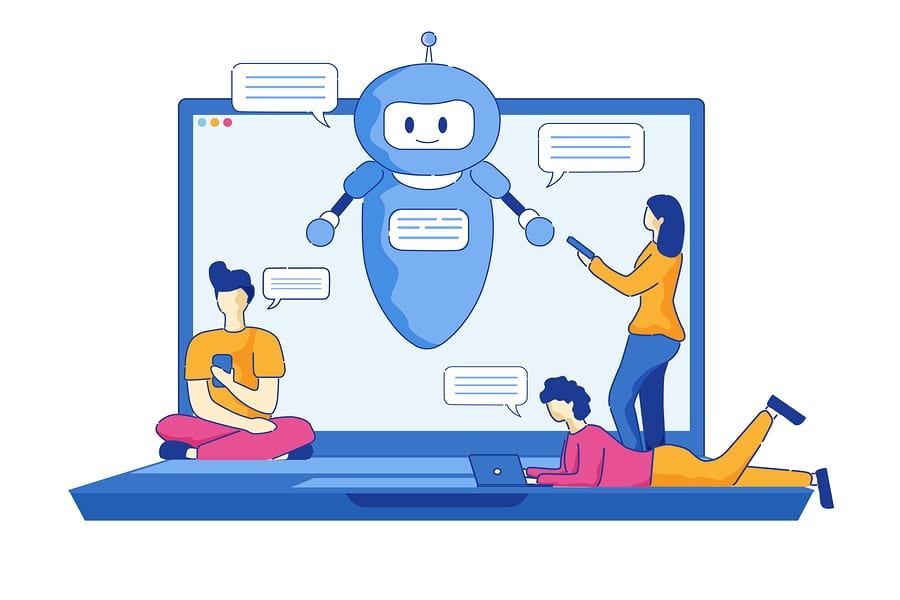How to Use Chatbot Marketing for Your Online Store

Marketing is important for all companies, brick-and-mortar and ecommerce alike. But the same type of marketing strategies you’d use for a brick-and-mortar store cannot be the same type of marketing strategies that you’d use for an online store.
Where brick-and-mortar retailers give people the ability to walk around, see and touch things, online marketplaces cannot provide the same type of hands-on customer experience. So how can you make your online customers’ experience as memorable and worthwhile as your in-store customers’ experience? The simple answer: Chatbots.
Chatbot Marketing is a Must
Believe it or not, chatbots are the online face of customer service. Gone are the days of relying on human customer service agents to answer customer queries in a timely manner. As companies globalize their reach, it’s important for people on the other side of the world to be able to access help in their time zone. There are many chatbot tools and plugins that integrate with all of the best ecommerce platforms online retailers run on.
You wouldn’t want to lose customers because your company is located in New York, but half of your clientele is located in India (that’s a time difference of nine hours and 30 minutes). Then comes the question of what you should do to bridge the time gap in terms of customer service needs. Without hiring staff who work 24/7, it seems impossible to provide customer service at varying times of day to serve a global customer base. But chatbots can easily remedy this issue.
Chatbot Marketing in Ecommerce
Chatbots make customers’ shopping trips a more memorable, enjoyable experience in more ways than one. The following examples show how chatbots can be used to boost an online store’s overall marketing presence and positive perception to its customers.
- Personalize your customers’ online shopping experience
- Boost your sales and lower shopping cart abandonment rates
- Receive feedback about your store and your products
1. Personalize your customers’ online shopping experience
There’s a fine line between automated systems being creepy and knowing what we’re thinking and being helpful by making our interactions with them personalized and “real.” When using a chatbot on your website, you can make sure its interactions with your customers feel honest and natural, like real-life human-to-human interactions do.
Instead of programming your chatbot with canned responses, you can program your chatbot to communicate with your customers rather than at your customers makes a world of difference. Have your chatbot pop up on the screen and ask your customer’s name. This allows for a personalized experience that can be tailored depending on the time the customer spends on a page and what type of items they’re looking for.
In addition, your chatbot can show a ‘customers also viewed’ section. This will lead your customer to click additional products and pages on your site, prompting them to engage with your chatbot, and ultimately, your site.

2. Boost your sales and lower shopping cart abandonment rates
As an online marketplace, you already know that cart abandonment plagues the ecommerce industry. Someone fills up their cart with goods online, but navigates away from your site, gets distracted or decides against making a purchase. This causes you to lose out on valuable sales, even if you think your overall marketing strategy is flawless.
To lower your shopping cart abandonment rates, a chatbot can swoop in and ensure your customers spend more time on the site, can ask questions about products, and get real-time recommendations about similar products (think Amazon). Chatbots can interact with your customers in a non-threatening manner that doesn’t put as much pressure on completing a sale as a human customer service representative would.
On top of this, even if your customer still decides they want to come back to their cart at a different time, your chatbot can take down the customer’s email address and send reminder emails about what they left behind in their cart, or special holiday marketing emails. Being reminded of the awesome products they had their eyes on will result in return customers who actually close a sale.

3. Receive feedback about your store and your products
Online stores often send their customers post-purchase emails to ask for product reviews as well as feedback on their general experience. But the open rate on those emails can be dismal, resulting in far fewer responses than anticipated. People might feel that emails asking for reviews seem disingenuous. Or maybe too much time has passed since the point of purchase to the time receiving the email.
To encourage more timely, actionable feedback, your chatbot can pop up once a transaction is made and ask the user to submit a quick review before exiting your site. If the pop-up chat box prompts them with clickable multiple-choice buttons, a customer is more likely to find the benefit of providing feedback, especially if it’s made into an easy process for them. Nobody likes responding to long emails, but everybody loves sharing their opinion. It’s a win-win!

How can I get started with a chatbot for my online store?
With all of these benefits in mind, you might be ready to hop on the chatbot bandwagon. But before you dive headfirst into unknown waters, you need to learn what type of chatbot software is right for your needs. Creating your very own e-commerce chatbot is easy enough with the tutorials out there, but it’s important to know which type of chatbot is best suited for your needs.
Whether you’re a small Etsy-based independent company, a mid-sized retailer with a few locations here and there or a multi-million enterprise company with a well-known name, chatbots can make all the difference in your success against your competitors.
 Author bio: Rebecca Reynoso is a tech writer on the Content Marketing team at G2. She focuses on AI, chatbots, and related high-tech content. Her passion for writing led her to study English, receiving a BA and MA from UIC and DePaul, respectively. In her free time, she enjoys watching Blackhawks games and spending time with her family and cat. Follow her on LinkedIn.
Author bio: Rebecca Reynoso is a tech writer on the Content Marketing team at G2. She focuses on AI, chatbots, and related high-tech content. Her passion for writing led her to study English, receiving a BA and MA from UIC and DePaul, respectively. In her free time, she enjoys watching Blackhawks games and spending time with her family and cat. Follow her on LinkedIn.
Share On:








